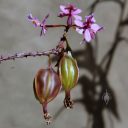Teeny-Tiny Orchid Seeds
Posted December 7th, 2018 by Marc CohenCategories: Growing, Misc, Photos
How small are orchid seeds? They’re the smallest seeds in the world, like specks of dust. In fact, those little black dots in vanilla ice cream are seeds, and they’re considered large for the orchid family. The photos below show greatly enlarged images of Epidendrum seeds. Each tiny white thread is actually an individual seed.
When an orchid flower is pollinated, it starts to curl up and fade, and an area below the flower starts to swell. That pod may take months to mature. Depending on the variety, it may contain tens of thousands, hundreds of thousands, or even millions of minuscule seeds. Eventually, the pod splits, and the seeds disperse in the wind. Vanilla beans are the best known examples of orchid pods which have been dried and cured.
In the wild, seeds must land in a spot that’s just right. Not only do they need a location with sufficient light, temperature, humidity, and water, but they need to land on the right fungus. With almost no nutrient reserves, these microscopic seeds rely on mycorrhizal fungi to supply their food. Orchids needs this fungal help for germination.
Why do orchids make so many seeds with minimal chances of surviving? It’s a numbers game — most will not live, but a few will germinate, grow, and flower to repeat the process.
In 1922, Cornell University botanist Lewis Knudson figured out how to germinate orchid seeds using a special nutrient solution instead of fungi. That revolutionized the orchid industry, and allowed mass production of some varieties. Since this method involves sterile conditions, lab equipment, and years of work, it’s not an option for most amateur growers. For those brave enough to try, check out this link with a home method. Most advanced growers pay labs to do the work for them.
For home growers, it’s important to consider that a seedpod is a drain on the orchid’s energy. If your goal is flowers, remove any seedpods to encourage more blooms. If you’d like to try your luck, let the pod stay on the plant and mature. Wait for it to split up the side. Scatter the seed in pots with the right growing conditions. Be sure to include the pot with the orchid mother plant, on the assumption that the necessary fungi are there. Only a very few may germinate. And be patient. It may take many months before you can spot any seedlings, and many more years before they reach blooming size. And marvel how these amazing flowers come from the smallest seeds.















































